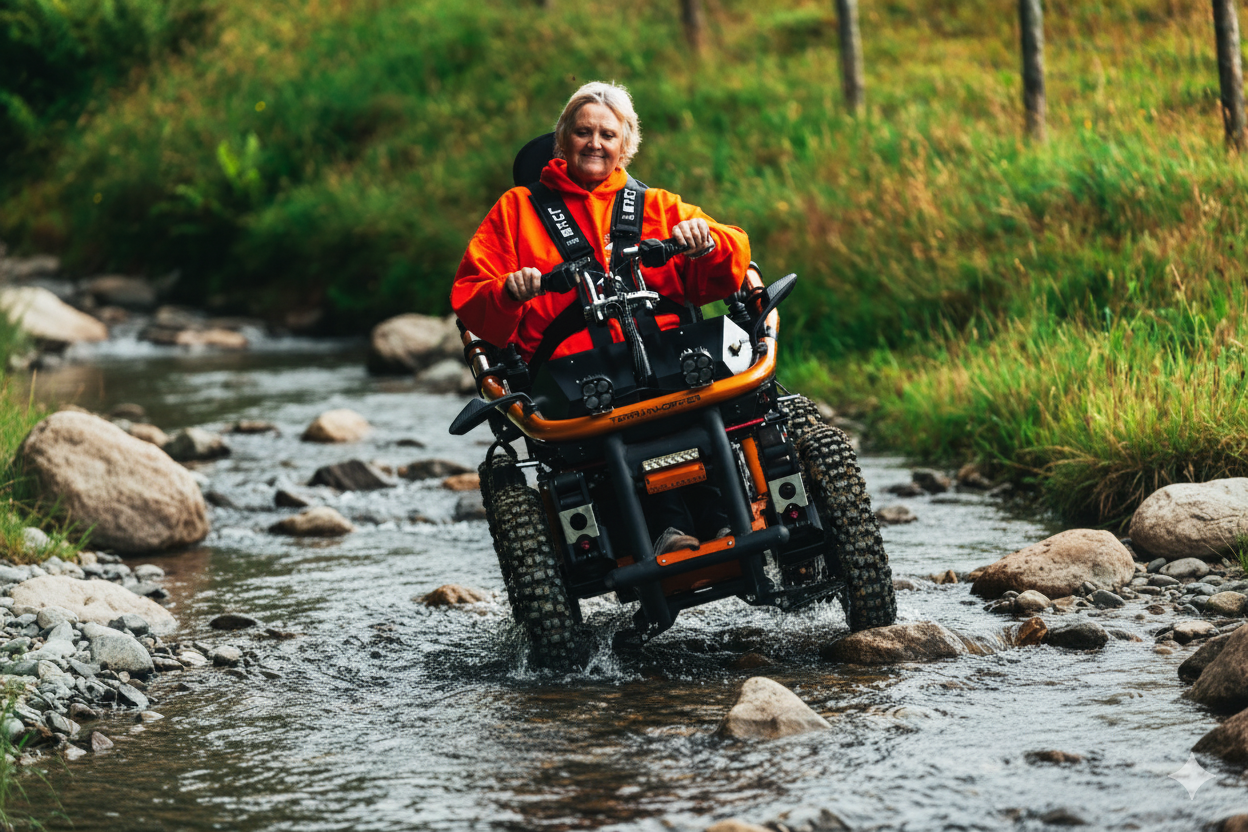Where am I allowed to use my off road mobility scooter? The rules explained.
Your TerrainHopper isn't just a mobility vehicle — it's a passport to the outdoors. Standard mobility scooters are mostly limited to pavements and flat surfaces. TerrainHopper all-terrain mobility vehicles are engineered for real landscapes: mountains, beaches, forests, moorland, rocky riverbeds, even shallow water and snow. With the right setup, places that felt off-limits become reachable.
This guide explains where you can take your TerrainHopper in the UK, how the law treats it, and how to explore safely and respectfully.
Key Takeaways:
- TerrainHopper is built for wild terrain — mountains, beaches, forests, moorland, National Parks — not supermarkets.
- Overlander 4ZX is Class 2 (up to 4mph on pavements, capable on trails and quiet roads). Flatlander is Class 3 (up to 8mph on roads, 4mph on pavements, with lights and mirrors).
- Groups like Access The Dales help users explore places like the Peak District, Yorkshire Dales and Lake District.
- Many routes are on private estates, forestry land and managed countryside accessed with permission.
- With four-wheel drive, ground clearance and suspension, TerrainHopper is all-season.
Understanding Your TerrainHopper: Built for Adventure, Not City Streets
TerrainHoppers are all-terrain mobility vehicles built for outdoor exploration. They use patented suspension, high ground clearance (around 120–250mm), high-torque motors and a reinforced chassis so you can handle mud, rocks, sand, ruts and slopes. They’re built for access, not indoor manoeuvrability.
Where TerrainHopper Excels
- Mountain trails and hills: The Overlander 4ZX can climb gradients up to 35°. The Flatlander handles 30% inclines. That means scenic ridgelines and summits like Pen y Fan become realistic.
- Beaches: Soft sand and shingle normally stop standard scooters instantly. TerrainHopper’s traction and torque let you reach the waterline.
- Forest and woodland trails: Roots, mud and rutted ground become manageable instead of impassable.
- Moorland and countryside: Heather, pasture and grassy farm tracks open up.
- Rocky terrain and riverbeds: Independent suspension absorbs jolts from stones and boulders.
- Shallow water crossings and winter use: With optional waterproofing you can cross shallow streams, and with care you can drive on snow and frozen ground.
Where TerrainHopper Is Not Ideal
- Shops and shopping centres: At roughly 850mm wide and well over 100kg, it’s too large and heavy for aisles.
- Public transport: It’s not foldable or easily carried onto buses, trains or planes.
- Hospitals and tight indoor spaces: You’re often not banned, but corridors and lifts are cramped.
- Busy pavements: While legal at pavement speed, it’s not designed for weaving through crowds.
Think of TerrainHopper as an outdoor 4x4, not an indoor scooter. Many people keep a smaller mobility aid for errands and use the TerrainHopper for real terrain.
UK Legal Classifications: Class 2 and Class 3 Mobility Vehicles
In UK law, powered mobility vehicles fall into classes. TerrainHopper models are Class 2 or Class 3, and that affects where you can go.
Class 2: Overlander 4ZX
- Speed: Up to 4mph in pedestrian areas. You may travel on the road at safe speed when necessary, especially in rural or low-traffic areas.
- Where you can use it: Pavements (4mph), certain public rights of way, bridleways and byways that allow motorised access, private land with permission, and suitable roads.
- Licence, tax, registration: None required.
- Insurance: Sensible for theft, damage and liability, though not mandatory.
- Reality: You can link short stretches of quiet road with trails, but the Overlander is happiest off road.
Class 3: Flatlander
- Speed: Up to 8mph on the road, and 4mph on pavements.
- Equipment: Class 3 vehicles must have lights, mirrors, horn and indicators. The Flatlander is built with these.
- Road use: You can drive on the road, but it’s not intended for fast traffic.
- Age: You must be at least 14 to drive a Class 3 vehicle on the road.
- Licence, tax, registration: Not required.
Both classes can be used, where lawful, on certain public rights of way, byways open to all traffic (BOATs), forestry trails and private land. Always check local signage and landowner rules. Using a TerrainHopper for personal mobility is not the same as joyriding a quad — be respectful.
UK National Parks: Your TerrainHopper Playground
National Parks are where TerrainHopper really shines. With planning, you can explore moorland, forest tracks, lakeside paths and upland viewpoints instead of staying in car parks.
Peak District National Park
Gritstone edges, moorland plateaus and limestone valleys. TerrainHopper users have reached viewpoints and upland tracks that would normally be inaccessible. Surfaces range from hard-packed stone to rocky paths. The Overlander 4ZX is ideal; confident Flatlander users can enjoy established trails with moderate gradients.
Lake District National Park
Mountains, wooded valleys and lakeshores. Not every fell path is suitable — some are too steep or boulder-strewn — but many lower-level lakeside and woodland routes are realistic. The Flatlander works on gentler ground; the Overlander can take on rougher sections. Always check gradient, surface and weather.
Yorkshire Dales National Park
Dale valleys, riverside tracks, limestone pavements and moor edges. Through Access The Dales you can get route recommendations, guided outings and even borrow a TerrainHopper. That removes guesswork if you’re new.
Snowdonia / Eryri National Park
Dramatic ridges and mountain views in Wales. While not every summit trail is suitable, valley and forest routes plus accessible low-level mountain paths are possible. Overlander 4ZX is best for steeper gradients and rocky ground. Mountain weather changes fast, so plan clothing, daylight and battery range.
Other notable areas include the Brecon Beacons (upland moor and woodland pockets), Northumberland National Park (remote and wild), the New Forest (flatter heath and woodland tracks, great for Flatlander users), and accessible parts of the Scottish Highlands (spectacular but remote — plan carefully).
Before you go, speak to park staff or accessible-outdoors groups. They’ll help you match a trail to your ability and chosen model.
Beaches and Coastal Exploration
For many wheelchair users, beaches are heartbreaking: you can see the sea but can’t reach it. TerrainHopper changes that.
- Sandy beaches: Wide tyres, torque and ground clearance let you cross soft sand where normal scooters instantly sink.
- Pebble and shingle: Independent suspension reduces vibration so travel is surprisingly comfortable.
- Rocky tidal flats: With careful driving and good visibility, the Overlander’s ground clearance helps you navigate firmer rock sections and tidal shallows.
- Shallow water: Optional waterproofing lets you drive through shallow pools and firm wet sand — but tides still demand respect.
Check local rules (some councils restrict motorised access), and plan around tide times so you’re never cut off. After any saltwater use, rinse with fresh water to protect the vehicle and stay within warranty conditions.
Forests, Woodlands, and Rural Trails
Forestry land, country estates and traditional farm tracks are perfect for regular outings and shorter adventures.
Many Forestry England / Scotland / Wales sites have gravel access roads and waymarked loops that are ideal for all-terrain mobility vehicles. Flatlander is usually enough for broad forest roads; Overlander handles deep mud, ruts and cambers. Popular examples include Thetford Forest, Kielder, Forest of Dean and Galloway. Stick to designated trails — off-track forest floors can hide drainage ditches and soft bog.
Some woodland trusts and reserves now publish accessibility info and even run guided outings for powered off-road mobility users. You’ll know in advance about gates, stiles, livestock or steep cambers instead of discovering problems mid-route.
Britain is also criss-crossed with historical tracks:
- Bridleways: Generally for walkers, cyclists and horses. Motorised access can be sensitive; check locally.
- Byways Open to All Traffic (BOAT): Public routes where motor vehicles are allowed. These rough farm and moorland tracks are excellent TerrainHopper territory.
- Green lanes / restricted byways: Rules vary. Read signage and respect restrictions.
Wherever you ride, follow the Countryside Code: close gates, avoid damaging trails, slow down for walkers, cyclists and horse riders, and leave no trace.
Private Land and Organised Access
Some of the best TerrainHopper experiences happen on private estates, farms and guided routes.
Access The Dales, based around the Yorkshire Dales, helps people with limited mobility experience rugged countryside. They run guided TerrainHopper outings, lend vehicles, recommend realistic routes and introduce you to a supportive outdoor community. This is especially useful if you’re deciding which model to buy or you’re nervous about tackling rough ground alone.
Many estates and farms will allow responsible access by arrangement, sometimes during specific accessibility days. Always ask first, avoid crops and livestock, and respect seasonal restrictions such as lambing or shooting.
Safety, Preparation and Care
Adventure freedom comes with responsibility. A little planning keeps you safe and protects the landscape.
Before You Set Out
Charge fully and know your realistic range. Steep climbs, cold weather and boggy ground drain batteries faster. Check tyres, lights and indicators. Bring a phone, essential medication, basic first aid and weatherproof clothing. Review the forecast and daylight hours — in winter, assume dark arrives early.
Route Planning
Research gradient, surface and distance. Identify fallback routes if ground is worse than expected. Tell someone where you’re going and when you’ll return, especially in winter or remote terrain.
Respect the Land
Follow the Countryside Code. Leave gates as you found them, slow down for walkers, cyclists and horse riders, and give livestock space. Stay on obvious lines to reduce erosion.
After the Ride
Rinse off mud, grit and salt (use a gentle hose, not a pressure washer). Check bolts, harnesses, suspension and wiring after tough outings. Keep battery terminals clean and recharge promptly. Heavy, regular off-road use may need inspection every few months; typical leisure use usually needs an annual service.
Your Adventure Begins Here
TerrainHopper is freedom. It lets you share beaches instead of watching from the car park, reach viewpoints instead of settling for the visitor centre, and travel moorland, forest and fell on your own terms. The UK’s landscapes — dales, ridgelines, lochs, coastlines, ancient woodland — are waiting.
Ready to see what’s possible next? Call 01472 566566 or book a test drive to experience the capability first-hand, get route guidance and plan your next adventure.








